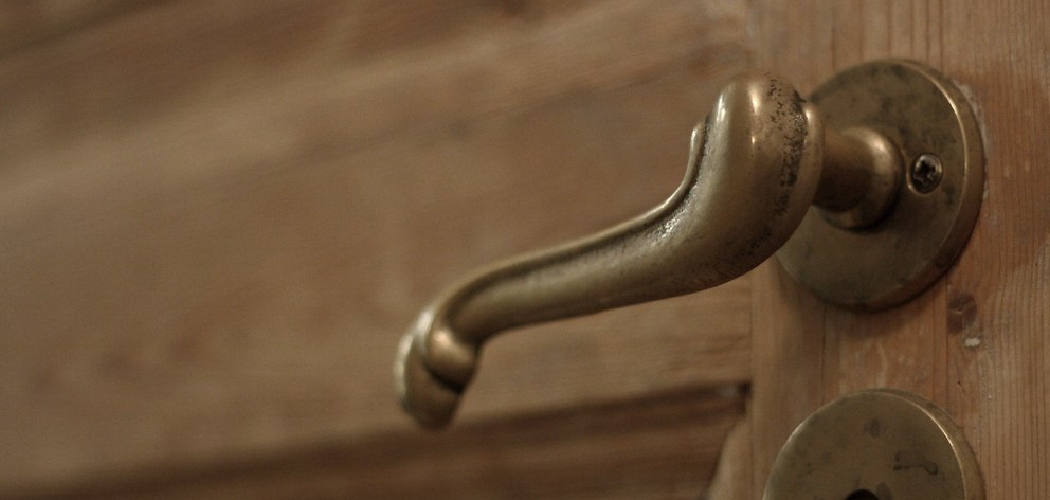Are you tired of your storm door slamming in the wind or failing to close fully? The solution is simple: lock your storm door. While it may seem like a trivial task, there are proper techniques and steps to ensure that your storm door is locked securely.
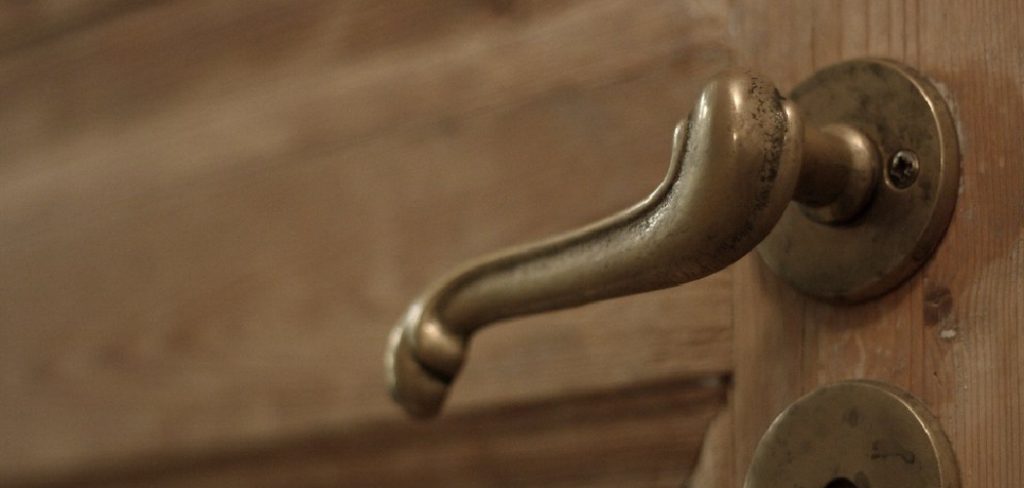
Locking a storm door is essential in securing your home against harsh weather conditions and potential intruders. While the process might seem straightforward, ensuring a proper lock can significantly enhance your door’s efficacy and longevity.
This guide will provide you with step-by-step instructions on how to lock storm door, utilizing the right techniques and tools to ensure peace of mind and protection for your home. Whether you are a seasoned homeowner or new to home maintenance, mastering the art of locking your storm door is a valuable skill.
What are the Benefits of Locking Storm Doors?
Before we dive into the process of how to lock a storm door, let’s first understand why it is essential. Here are some benefits of locking your storm door:
- Enhanced Security: A locked storm door adds an extra layer of security to your home, making it more challenging for potential intruders to enter.
- Protection Against Weather: A properly locked storm door can prevent strong winds and debris from damaging your home’s main exterior door.
- Energy Efficiency: Locking your storm door creates an airtight seal, preventing drafts and increasing energy efficiency in your home.
- Peace of Mind: Knowing that your storm door is securely locked provides peace of mind, especially when you are away from home.
Now that you understand the importance of locking your storm door let’s dive into the steps to do it correctly.
What Will You Need?
Before starting the process, make sure you have the following tools and materials on hand:
- Storm door key (if applicable)
- Phillips head screwdriver
- Lubricant spray (optional)
- Cleaning cloth (optional)
Once you have these materials ready, let’s get started!
10 Easy Steps on How to Lock Storm Door
Step 1. Inspect the Door:
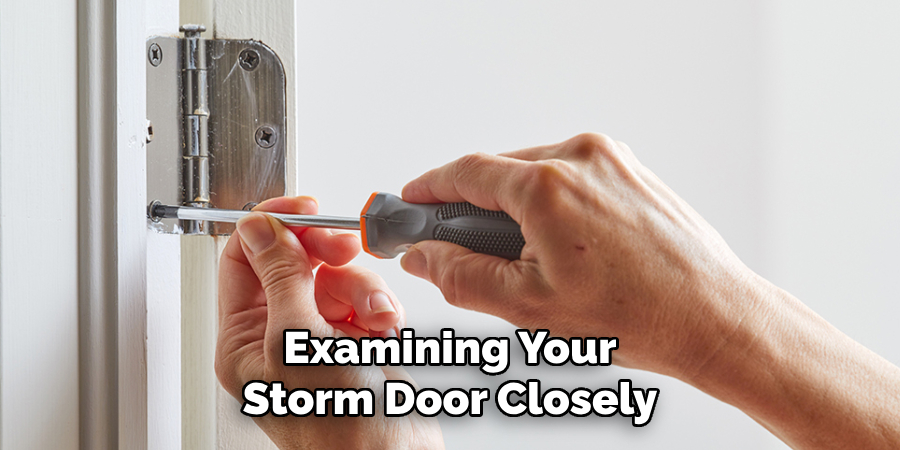
Begin by examining your storm door closely. Look for any visible signs of damage or wear and tear on the door frame, hinges, and the locking mechanism itself. Ensure that the door sits properly within its frame and that there are no gaps or misalignments. If your door has a screen or glass panel, check for any cracks or holes that might need fixing.
Conducting a thorough inspection will help you identify any issues that could hinder the locking process and ensure that the locking mechanism operates smoothly. If you find any problems, address these before proceeding to the next steps. Remember, the effectiveness of your storm door’s lock is only as good as the door’s overall condition.
Step 2. Clean the Locking Mechanism:
After ensuring your storm door is in good condition, the next step is to clean the locking mechanism. This includes the lock, handle, and any part of the door that engages with the lock. Use a cleaning cloth to wipe away any dirt, dust, or debris. If the mechanism is particularly grimy or seems to stick when locking or unlocking, applying a small amount of lubricant spray can help.
Be sure to wipe away any excess lubricant to prevent it from attracting more dirt. Keeping the locking mechanism clean not only helps it function smoothly but can also extend its lifespan.
Step 3. Check the Alignment of the Door:
Once the locking mechanism is clean, the next crucial step is to check the alignment of the door within its frame. A storm door that is not properly aligned may not lock correctly, leaving gaps that compromise both security and energy efficiency. To check alignment, close the door gently and observe any gaps between the door and the frame, especially near the lock area.
Ensure that the door latch aligns perfectly with the strike plate. Adjustments to the door’s positioning may be required, which might involve loosening the hinges and realigning the door before tightening them back in place. Proper alignment is key to a smoothly functioning locking mechanism.
Step 4. Test the Lock Before Securing:
With your storm door properly aligned, the next step is to test the lock before fully securing the door. Close the door gently and turn the key or handle to lock the door without applying extra force. Then, check if the lock engages smoothly and firmly. If you’re using a key, ensure that it turns without resistance.
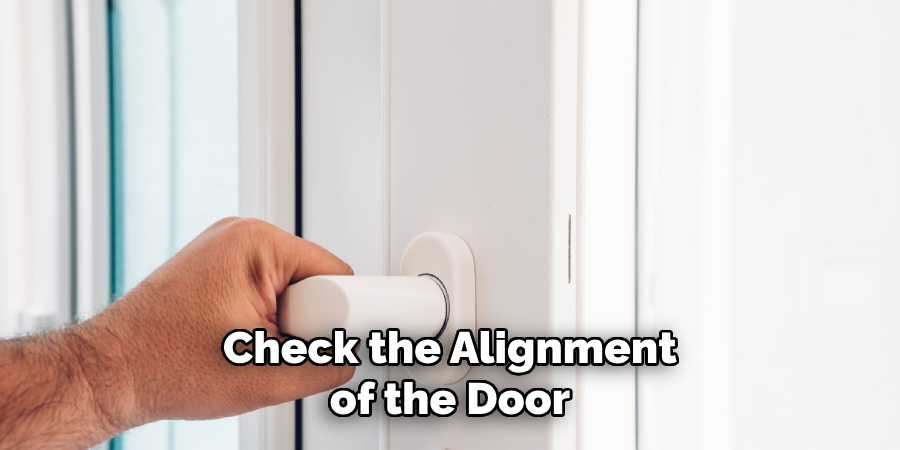
This preliminary test helps to confirm that the cleaning and alignment steps have been effective. If the lock does not engage smoothly, it may indicate that further adjustments or cleaning is necessary. Testing the lock beforehand ensures that when you do secure your storm door, it will be properly locked and provide the safety and efficiency you need.
Step 5. Secure the Door Firmly:
Once the lock has been tested and is working smoothly, proceed to close your storm door firmly. Make sure that it is fully closed, with no gaps between the door and the frame. Firmly press or pull the door to ensure it is as tight against the frame as possible before locking.
This step is crucial for creating an airtight seal, which contributes to your home’s energy efficiency and provides an additional layer of security. A firmly closed door ensures that the lock can engage fully and effectively, leveraging the door’s design to enhance protection against weather elements and potential intruders.
Step 6. Engage the Lock:
Now that the door is firmly closed, it’s time to engage the lock. Turn the key or handle to lock the door, ensuring the locking mechanism fully engages. If your storm door has a deadbolt, make sure to use it, as it provides an added layer of security. Listen for the click or any indication that the lock is properly set.
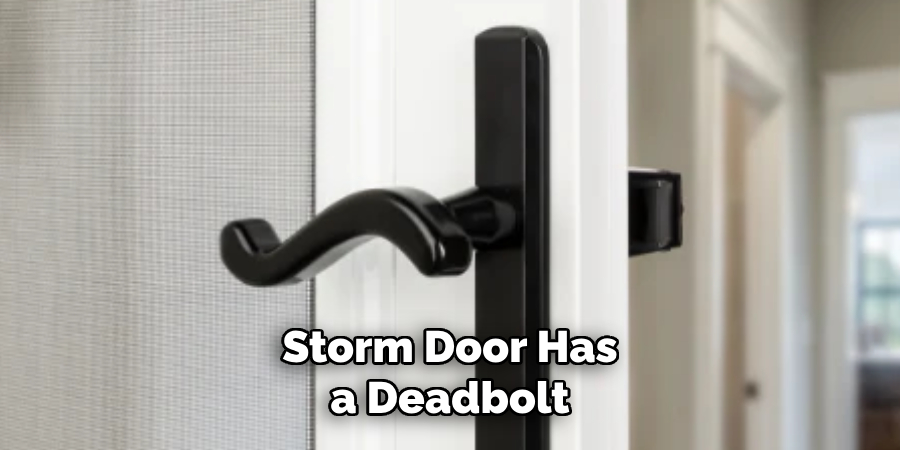
For doors with electronic locks, ensure that the indicator shows that the door is locked. This step is vital for securing your home and should be done with attention to ensure that the lock is properly engaged and cannot be easily tampered with.
Step 7. Verify the Lock from Outside:
Once you have locked the storm door from the inside, verifying that the lock is engaged from the outside is important. Gently pull and push on the door to ensure that it does not open and that the lock is fully engaged. This step is crucial for ensuring that your home is secure when you’re away or during the night.
A quick double-check can provide peace of mind, confirming that your efforts to secure the door have been successful. Additionally, it helps to identify any issues that might have been overlooked, such as a misaligned latch or a loose handle, which can then be addressed promptly.
Step 8. Regular Maintenance Checks:
Regular maintenance checks are essential to ensure the longevity and optimal performance of your storm door’s locking mechanism. Periodically inspect the lock, hinges, and doorframe for any signs of wear or damage. Ensure the locking mechanism is clean and lubricate it when necessary to keep it functioning smoothly.
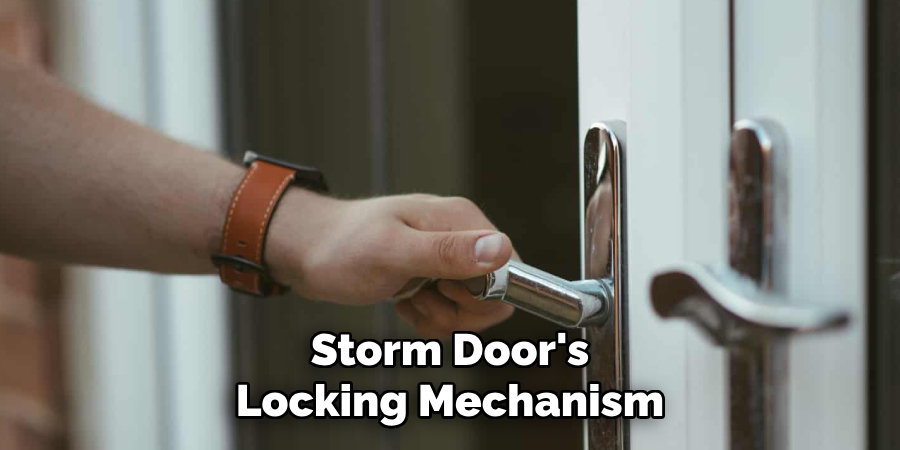
Adjustments to the alignment of the door should also be made as needed. By keeping an eye on the condition of your storm door and addressing any issues promptly, you can ensure that your door remains secure, efficient, and effective at protecting your home against the elements and unwanted guests.
Step 9. Review Security Features Periodically:
Beyond routine maintenance, it’s beneficial to periodically review the security features of your storm door. Advances in door technology might offer new locking mechanisms or security enhancements that can be retrofitted to your existing door.
Additionally, check if the door’s security features are in alignment with the overall security strategy of your home. This might include integrating smart locks that can be monitored remotely or adding additional locks for enhanced security. Keeping abreast of new security technologies and features can provide an added layer of protection and peace of mind.
Step 10. Educate Household Members on Proper Use and Security Measures:
Finally, it is essential to educate all household members on the proper use of the storm door and the importance of maintaining security measures. This includes showing them how to lock and unlock the door correctly, ensuring they understand the significance of keeping the door locked when necessary, and acquainting them with any additional security features your door may have.
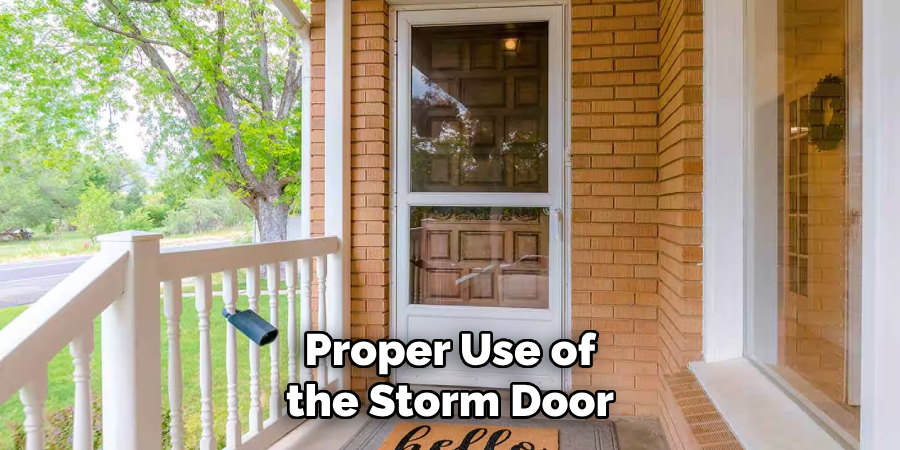
Regular reminders to close and lock the door after entering or leaving the house can reinforce security habits. Furthermore, if your storm door includes advanced features like smart locks, make sure everyone knows how to use them effectively. This collaborative approach towards door security can significantly enhance the safety and security of your home.
By following these steps and properly securing your storm door, you can ensure that your home is well-protected and energy efficient.
5 Additional Tips and Tricks
- Reinforcing the Lock: If you want extra security for your storm door, consider reinforcing the existing lock with a keyless deadbolt or a slide lock. These additional locks can provide increased protection against forced entry and give you peace of mind when leaving your home.
- Choose High-Quality Locking Systems: When purchasing a new storm door or replacing the existing lock, opt for high-quality locking systems from reputable brands. This will guarantee better durability and reliability compared to cheaper alternatives.
- Teach Children Proper Locking Habits: If you have children at home, it’s important to teach them proper locking habits when using the storm door. Make sure they understand the importance of keeping the door locked when leaving or entering the house and how to properly operate the lock for optimal security.
- Replace Worn Out Locks: Over time, locks can become worn out and less effective in securing your storm door. If you notice any signs of wear, such as difficulty turning the key or a loose lock mechanism, it’s best to replace it with a new one to ensure maximum security.
- Consider Adding Security Features: In addition to reinforcing the locking system, consider adding additional security features such as a door alarm or motion sensor lights near your storm door. These extra measures can deter potential intruders and provide an added layer of protection for your home.
By following these tips and tricks, you can ensure that your storm door remains locked and secure at all times.
5 Things You Should Avoid
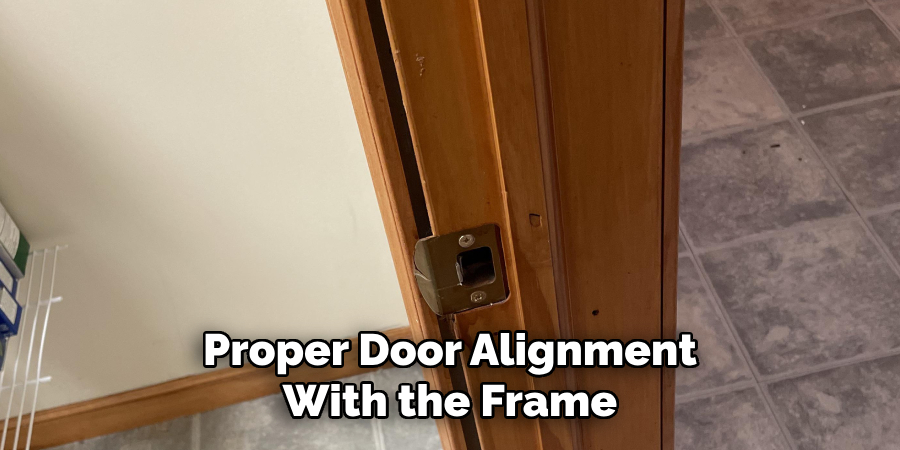
- Ignoring the Door’s Alignment: A common mistake is overlooking the importance of proper door alignment with the frame. Misalignment can cause the lock not to engage correctly, making it easier for intruders to breach. Regularly check and adjust the alignment for smooth locking mechanisms.
- Using WD-40 or Similar Products for Lubrication: While it might be tempting to use readily available lubricants like WD-40 on the locking mechanism, it’s best avoided. Such products can attract dirt and gum up the lock over time. Instead, use a silicone-based lubricant specifically designed for such purposes.
- Neglecting to Update or Upgrade Locks: Keeping outdated or worn locks on your storm door can compromise your home’s security. Avoid holding onto locks that are showing signs of wear or are outdated in terms of security features. Upgrading to a modern locking system can significantly enhance security.
- Failing to Use All Available Locks: If your storm door comes with multiple locking mechanisms (e.g., top and bottom locks), not utilizing all of them can leave your door less secure. Ensure that all available locks are engaged every time you lock the door for maximum protection.
- Leaving Keys in Obvious Places: Never leave spare keys under mats, planters, or in other predictable spots near the door. This is a common oversight that can easily be exploited by burglars. If you need to leave a key outside, consider a more secure solution, like a combination lockbox placed out of plain sight.
By steering clear of these common mistakes, you can maintain a higher level of security for your storm door and your home overall.
How Do You Keep a Storm Door Open?
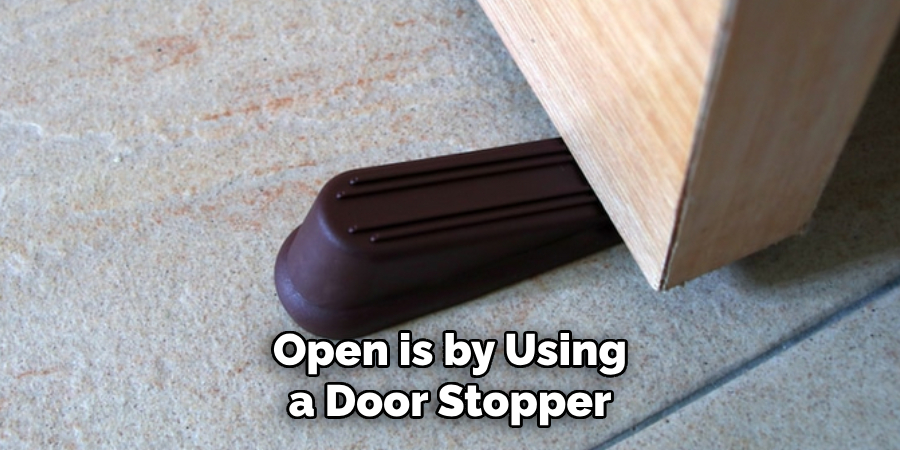
- Door Stopper: One simple and effective way to keep a storm door open is by using a door stopper. Door stoppers come in various designs, such as wedge-shaped rubber stoppers or magnetic ones that attach to the door frame. Place the door stopper at the desired position along the bottom edge of the door to keep it securely open.
- Hook and Eye Latch: A hook and eye latch is a more permanent solution for keeping a storm door open. It consists of a small hook attached to the door’s bottom edge, which engages with an eye screw on the door frame when the door is opened. This will keep the door from closing until you release the latch manually.
- Tie-Backs or Bungee Cords: For a quick fix, you can use tie-backs or bungee cords to secure the door in an open position. Attach one end of the cord to the door’s handle and the other end to a nearby object, such as a railing or doorknob. This will prevent the door from closing unexpectedly.
- Retractable Door Closers: Retractable door closers are devices that are installed on the inside of the storm door and allow you to adjust how wide the door can open. By setting it to a wider opening, you can keep the door open while still maintaining some control over how far it opens.
- DIY Solutions: If you don’t have any of the above options available, you can also get creative and make your own DIY door stopper or latch. For example, you could use a heavy book or a filled water bottle to keep the door open temporarily. However, these solutions are not as reliable or long-lasting as the other options mentioned.
Whichever method you choose, make sure to always keep an eye on the open door to ensure it doesn’t unexpectedly close and cause any accidents. By using these tips, you can easily keep your storm door open for better ventilation or while moving large items in and out of your home.
Conclusion
Ensuring your storm door is properly locked is crucial for the safety and security of your home. By implementing the practical tips and avoiding common mistakes outlined in this guide, homeowners can significantly enhance the effectiveness of their storm doors as a protective barrier.
Whether it’s upgrading your locking system, maintaining the door’s alignment, or adding additional security features, each step contributes to creating a safer home environment. Stay vigilant and prioritize regular checks and maintenance, and your storm door will serve as a reliable safeguard for years to come.
Hopefully, this guide on how to lock storm door has provided you with the knowledge and tools to confidently secure your storm door. Remember, prevention is always better than a cure when it comes to home security. Take the necessary precautions now to avoid potential risks and protect your home and loved ones. So, don’t wait any longer – go out and give your storm door the attention it deserves! Happy locking!

